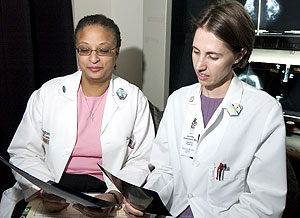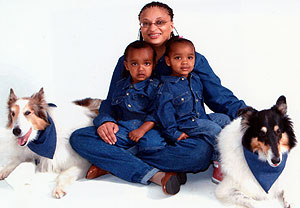Although breast cancer is more common among white women, African-American women are far more likely to die of the disease.
What accounts for this fundamental racial imbalance? Dione Farria, M.D., knows all too well: African-American women are less likely to get mammograms that can detect breast cancer early when it is more easily treated.

Socioeconomic influences such as limited access to health care, mistrust of the health-care system and the lack of health insurance, both for screening and treatment, play a major role in this disparity.
For Farria, the inequity in breast cancer deaths has been a personal call to action. A radiologist who specializes in breast imaging, she is one of the rare few in the field who also holds a master’s degree in public health. Her work to improve the quality of health care for people in less privileged segments of society helps Farria understand the barriers to cancer screening in a way that most radiologists don’t.
“Mammography screening for breast cancer is a huge public health issue,” says Farria, assistant professor of radiology. “In parts of St. Louis City and North St. Louis County, we see twice as much advanced breast cancer than would be expected.
“Many of these women are not aware of their breast cancer risk or are fearful of getting a mammogram. Those are precisely the women we are trying to reach.”
Farria is reaching out to African-Americans, the uninsured and immigrants in the city through the Siteman Cancer Center’s Program for the Elimination of Cancer Disparities, a program she co-directs with Katherine Mathews, M.D., assistant professor of obstetrics and gynecology.
In this role, Farria draws on her expertise in breast screening and public health to develop programs that encourage screening for breast cancer and other common cancers with well-established racial disparities — lung, colorectal and prostate.
Through this effort, Farria is determined to overcome the barriers that prevent people from minority backgrounds from getting the cancer screening tests and follow-up care they need.
“Dione has a deep and abiding commitment to each project she takes on,” Mathews says. “But just as important, she has a special ability to connect with people. It’s not just about the technology or her expertise, but about these personal connections. This skill has contributed greatly to the success of the program in reaching out to the minority community.”
Passion for public health
As a Harvard University medical student, Farria was attracted to radiology, but she almost opted for a career as a pediatrician out of concern that radiology wouldn’t provide opportunities to pursue her interest in public health. During her fourth and final year at Harvard, Farria traveled to the West African nation of Liberia for rotations in both pediatric and adult medicine. Although still a student, she spent many nights as the on-call doctor for a 130-bed hospital and its bustling emergency room.
Her first experiences with dying patients, especially children, occurred there.

“I can still recall vividly the wails of the mothers every morning as they mourned the deaths of their children, who had died the night before,” she says. “Despite my limited medical training, this was by far the most meaningful and rewarding clinical experience of my career.”
It also influenced Farria’s decision a decade later to adopt twins — a boy and a girl — from Ethiopia, a country with 5 million orphans. The children, Ethan and Eva, who were six months old when they came to the United States, are now 4 and heading to preschool.
After graduating from medical school in 1989, Farria returned to Liberia as an intern for a rotation in a hospital in Monrovia, and later did a stint at a Navajo pediatric health clinic in New Mexico. But ultimately, she chose radiology as her specialty.
“As a radiologist, you can focus on almost any aspect of medicine,” Farria says. The field’s rapid growth and evolution due, in part, to new imaging methods, also was an attraction.
After a clinical fellowship in breast imaging at the University of California, Los Angeles (UCLA), Farria decided to merge her training in radiology with her interest in public health by enrolling in UCLA’s School of Public Health. Not one to do anything half-heartedly, she also did a second residency in preventive medicine at the same time.
Farria came to WUSTL in 1999, seeking a career in academic medicine. She was drawn by the highly regarded Mallinckrodt Institute of Radiology and the reputation of the medical school, but was equally impressed by the people with whom she would be working.
Farria’s background in both radiology and public health proved to be just what Washington University was looking for.
“The public health aspects of breast imaging were well known to us,” says Barbara Monsees, M.D., the Ronald and Hanna Evens Professor of Women’s Health and head of the breast imaging section.
“I believed (Dr. Farria) possessed the skill set, the smarts and the drive to be an outstanding clinician and to address some of the barriers that stand in the way of women getting care.”
Evaluating screening tools
In addition to an active practice in patient care, in which she interprets breast images of all sorts — MRIs, ultrasounds and mammograms — Farria is engaged in clinical trials to evaluate imaging technologies for breast cancer.
|
Dione Farria, M.D. Education: Bachelor’s degree in chemistry, Xavier University of Louisiana, 1985; medical degree, Harvard Medical School, 1989; master’s degree in public health, University of California, Los Angeles, 1997 Family: Twins Ethan (4) and Eva (4) Hobbies/interests: Her dogs Duste and Gypsy (especially enjoys taking them for a trek through an obstacle course), gardening, church activities, reading and French Favorite recent books: Your Best Life Now by Joel Osteen, The Watsons Go to Birmingham by Christopher Paul Curtis, Memoirs of a Geisha by Arthur Golden |
She was the local principal investigator of a recent nationwide study that compared digital mammograms to the traditional, film-based scans. Digital mammograms produce images on a computer screen, where they can be enhanced to reveal looming signs of cancer.
The study found that digital mammography was better at detecting cancer in young women and those with dense breasts.
Farria is now the principal investigator at WUSTL for a multi-center study evaluating whether breast screening with ultrasound is better than mammography in detecting breast cancer in high-risk women, including those who are African-American.
Increasingly, she devotes her time to the Program for the Elimination of Cancer Disparities.
When it was established in 2003, Farria’s main role was to develop strategies to increase minority enrollment in clinical trials at Siteman.
“We quickly realized that to really increase participation in clinical trials, you really have to have an active presence in the community and provide clinical care, not just research care,” Farria said.
Thus began the effort to partner with local organizations and leaders to educate community members about their cancer risks and to provide screening services and follow-up care. These efforts have also increased African-Americans’ participation in clinical trials, which is vital to improving treatment and, ultimately, their survival.
Last year, on the basis of the program’s successes, the National Cancer Institute awarded Siteman a five-year, $1.25 million grant to support ongoing outreach efforts. In St. Louis, the primary target is African-Americans, but programs benefit low-income individuals of all races, as well as immigrants and those living in rural areas.
The breast cancer screening program is the most developed of these efforts.
“We tell all the women, ‘Don’t let insurance be a barrier. If you come for a mammogram, we will get you one. Don’t worry if you don’t have the money,'” Farria says.
Thanks to generous funding from philanthropic groups, the University can pay for mammograms for poor women, even if they don’t qualify for Medicaid.
“Many women worry that if breast cancer is detected, they can’t afford the care. We make sure they will get the proper treatment and follow-up care,” she said.
When Farria’s not working, she enjoys swimming at the YMCA with her children or taking them to the park or a movie. She likes to spend time with her two dogs and takes pleasure in her African-American women’s book club.
A New Orleans native, Farria has spent the past year providing help and encouragement to her extended family, many of whom were displaced after Hurricane Katrina ravaged the area. Four family members even stayed with Farria while they were getting back on their feet. But she considers her family lucky, all survived the storm and many are working their way back to the city.